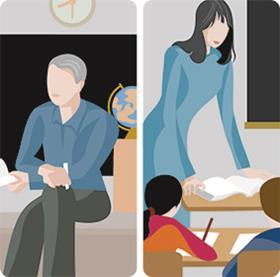Do you come across as relaxed and at ease in the classroom? Or do you give off signals of nervousness and discomfort? Like it or not, your body language speaks volumes about how you feel in class.
As language teachers, a lot of our time is spent trying to get messages across to our students and understanding the messages they send us. Often, this means choosing our words very carefully, speaking slowly and clearly, and repeating where necessary. But, communication doesn’t end with what we say and how we say it. Non-verbal communication is also powerful. This is especially true if you are communicating with someone in a language that isn’t their native tongue and over which they have little mastery.
Look into my eyes … but not too deeply!
When people talk to each other in everyday conversation, they often look at each other only briefly. The speaker looks occasionally at the listener to check that they are listening. The listener looks at the speaker, but will avert their gaze when the speaker looks at them. While we don’t think about it that much, we are sensitive to variations in this pattern. Failure to break away from each other’s gaze indicates a strong emotion. This could be extreme interest, passion or hatred. As such, we tend to get a little disconcerted when faced with this situation. Effective teaching requires good eye contact with your students. This way you can check they are listening and understanding. Often, this means making periodic sweeps of the class, meeting students’ eyes briefly and moving on.

What nervous teachers do
When we feel stressed, we seek reassurance. Touching and holding ourselves is one way this manifests itself in our body language. Crossing your arms is also a sign that you are closed and on the defensive. Be aware of the following, which are outward signs of the nervous and stressed teacher: scratching your head, clutching your hand to your mouth, fiddling with an article of clothing, constantly removing glasses or other objects (and putting them in your mouth), playing with your hair. These are examples of what anthropologists call grooming. If used to an extreme, they can become distracting. What’s worse, they stick in students’ minds and become ripe material for teacher impersonations!

What relaxed and confident teachers do
Confident, dominant individuals look relaxed. If you recognize yourself in any of the ’stressedteacher’ body-language postures from the previous section, you might want to try some of the:
- 1. Standing with your hands in your pockets - This prevents you from exhibiting nervousness by fiddling with your fingers. A loose jacket is best- don’t try cramming your hands into pockets on tight trousers!
- 2. Sitting - Sitting on a chair with one leg crossed over the other and the ultra-casual teacher pose of sitting on the edge of a desk both convey a relaxed attitude.
- 3. Leaning - If you don’t want to go all the way and sit down, leaning on the table is the next best option.
The advantage of sitting and leaning is that these postures avoid the risk of pacing up and down or rocking on your heels. These are subconscious signs of a desire to escape. What’s more, pacing about like a caged lion can be very distracting. You may be unaware of how much you move around in class but your students will certainly notice and even more so if you look uncertain.
However, we do not advocate sitting firmly ensconced in your chair - or, even worse, behind a big desk. Use the classroom space inclusively, don’t just bounce about in it.
Monitoring your body language
If you haven’t already done so, start monitoring your body language. The most powerful way that you can become aware of your body language is to make a video of yourself giving a class and then watch it afterwards. Most teachers who try this agree that it comes as a revelation how they gesture, stand or sit in class. If you don’t have access to video equipment, then ask a colleague to watch you and give you feedback on your body language.
Effective body language is essential in establishing a positive classroom presence. If you can outwardly convey confidence and calm, you will feel more motivated to go on. Your learners will be more willing to go along with things, as well. Just ask any politician or high-profile public speaker! Inexperienced teachers, nervous and jittery before class, tend to display negative signals almost as soon as they walk through the door. This results in problems with classroom management and discipline. People say that aggressive dogs can smell fear. Classrooms full of students also have quite a nose for teacher insecurity!
Top tips for effective body language for teachers
Observation
Over the next day or two, observe people talking to each other in their native language in a series of different contexts. How do they express interest and enthusiasm with their body language? How do they show stress?
Eye contact
- Don’t get worried if the whole class is staring at you. This could simply mean they’re interested in what you’re saying, as the unspoken rules on eye contact during a whole-class interaction are not the same as during a one-to-one conversation (the whole class hasn’t fallen in love with you, nor do they necessarily hate you). You will find that, if you look into individual students’ eyes, they will avert their gaze.
- Look at students who are speaking to you. This sends the message ’I am listening and interested.’ Turning away, wiping the board or looking through a book all send the opposite message: ’The other thing I am doing is more important than you.’
- Do not stare into the middle distance over the students’ heads. This is characteristic of nervous teachers, as is constantly staring down at your book or papers. This will lead to lack of communication with and control over your class.
- Be aware that a sustained gaze at a student who is talking to you can make them feel stressed and under the microscope.
Nervous body language
Remember the following are all typical of nervous teachers or speakers. Try to avoid them if you can.
Clutching the book to your chest makes you look defensive.
- Standing with your arms tightly crossed sends the signal that you are closed and on the defensive.
- Scratching the back of your head can send the message that you are confused or unsure.
- Scratching or stroking your face can be interpreted in different ways. It can mean ’This is a difficult point’ but it is also seen as characteristic of lying and deceitfulness! So do it sparingly.
Positive body language
These postures are characteristic of calm and confident teachers. Try them if you find you are getting a bad case of the nerves.
- Standing with your hands in your pockets will help stop nervous fidgeting.
- Sitting on a chair with your legs crossed makes you look more relaxed.
- Gesturing, not pointing, to nominate someone.
Downloads
Click link to download and view these filesSurvival Guide: Effective teacher body language: Article
PDF, Size 0.2 mb
Credits
BIBLIOGRAPHY
Miller, Patrick W. Body Language: An Illustrated Introduction for Teachers. Patrick W Miller & Associates, 2005.
Morris, Desmond. Manwatching: A Field Guide to Human Behaviour. Triad Books, 1978.
Neill, Sean and Caswell, Chris. Body Language for Competent Teachers. Routledge, 1993.
Introduction to Survival Guide
- 1
- 2
- 3
- 4
- 5Currently reading
Survival Guide: Effective teacher body language
- 6
- 7
- 8
- 9
- 10
- 11
- 12
- 13
- 14
- 15
- 16
- 17
- 18
- 19










No comments yet